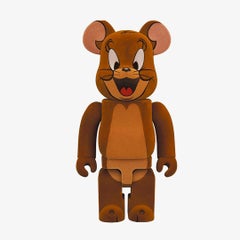Bearbrick Tom And Jerry
Recent Sales
2010s Street Art Sculptures
PVC
A Close Look at street-art Art
Street art is a style created for city walls, subway trains and other public spaces. Sometimes it is commissioned, yet most often it is an individual statement of defiant free expression. Although mostly an urban style, street art can be found all over the world, including JR’s pasted portraits on the separation wall in Palestine, Invader’s playful ceramic tile mosaics in Paris and the provocative stencil and spray-paint works by Banksy in London.
The Philadelphia-based Cornbread — aka Darryl McCray — is considered the first modern graffiti artist. He began tagging his name around the city in the 1960s. Graffiti art later flourished in New York City in the 1970s. There, young artists used spray paint and markers to create tags and large-scale graphic works, with Jean-Michel Basquiat and Keith Haring both developing their distinctive styles through the graffiti scene, which would evolve into street art. Artists such as Tracy 168 and Lady Pink pioneered the Wild Style of complex graffiti writing in the 1980s, pushing the movement forward.
Because of its unsanctioned, improvisational and frequently covert nature, street art involves a range of techniques and aesthetics. Some street artists use quick and effective stenciling, whereas others wheat-paste posters, commandeer video projectors or freehand draw elaborate illustrations and murals. Shepard Fairey made his mark with street art stickers before designing the iconic “Hope” poster for Barack Obama’s 2008 presidential campaign.
While the origins of street art are rooted in a strictly noncommercial creative act that confronted political issues, sexuality and more for a general audience of passersby, the art form has moved inside the galleries over the years. Today, just as Basquiat and Haring took their works from Manhattan’s Lower East Side alleyways into Soho galleries, artists including KAWS, Barry McGee and Osgemeos are in demand with collectors of fine art.
Find a collection of street art paintings, sculptures, prints and multiples and more on 1stDibs.
Finding the Right sculptures for You
The history of sculpture as we know it is believed to have origins in Ancient Greece, while small sculptural carvings are among the most common examples of prehistoric art. In short, sculpture as a fine art has been with us forever. A powerful three-dimensional means of creative expression, sculpture has long been most frequently associated with religion — consider the limestone Great Sphinx in Giza, Egypt — while the tradition of collecting sculpture, which has also been traced back to Greece as well as to China, far precedes the emergence of museums.
Technique and materials in sculpture have changed over time. Stone sculpture, which essentially began as images carved into cave walls, is as old as human civilization itself. The majority of surviving sculpted works from ancient cultures are stone. Traditionally, this material and pottery as well as metal — bronze in particular — were among the most common materials associated with this field of visual art. Artists have long sought new ways and materials in order to make sculptures and express their ideas. Material, after all, is the vehicle through which artists express themselves, or at least work out the problems knocking around in their heads. It also allows them to push the boundaries of form, subverting our expectations and upending convention. As an influential sculptor as much as he was a revolutionary painter and printmaker, Pablo Picasso worked with everything from wire to wood to bicycle seats.
If you are a lover of art and antiques or are thinking of bringing a work of sculpture into your home for the first time, there are several details to keep in mind. As with all other works of art, think about what you like. What speaks to you? Visit local galleries and museums. Take in works of public art and art fairs when you can and find out what kind of sculpture you like. When you’ve come to a decision about a specific work, try to find out all you can about the piece, and if you’re not buying from a sculptor directly, work with an art expert to confirm the work’s authenticity.
And when you bring your sculpture home, remember: No matter how big or small your new addition is, it will make a statement in your space. Large- and even medium-sized sculptures can be heavy, so hire some professional art handlers as necessary and find a good place in your home for your piece. Whether you’re installing a towering new figurative sculpture — a colorful character by KAWS or hyperreal work by Carole A. Feuerman, perhaps — or an abstract work by Won Lee, you’ll want the sculpture to be safe from being knocked over. (You’ll find that most sculptures should be displayed at eye level, while some large busts look best from below.)
On 1stDibs, find a broad range of exceptional sculptures for sale. Browse works by your favorite creator, style, period or other attribute.
